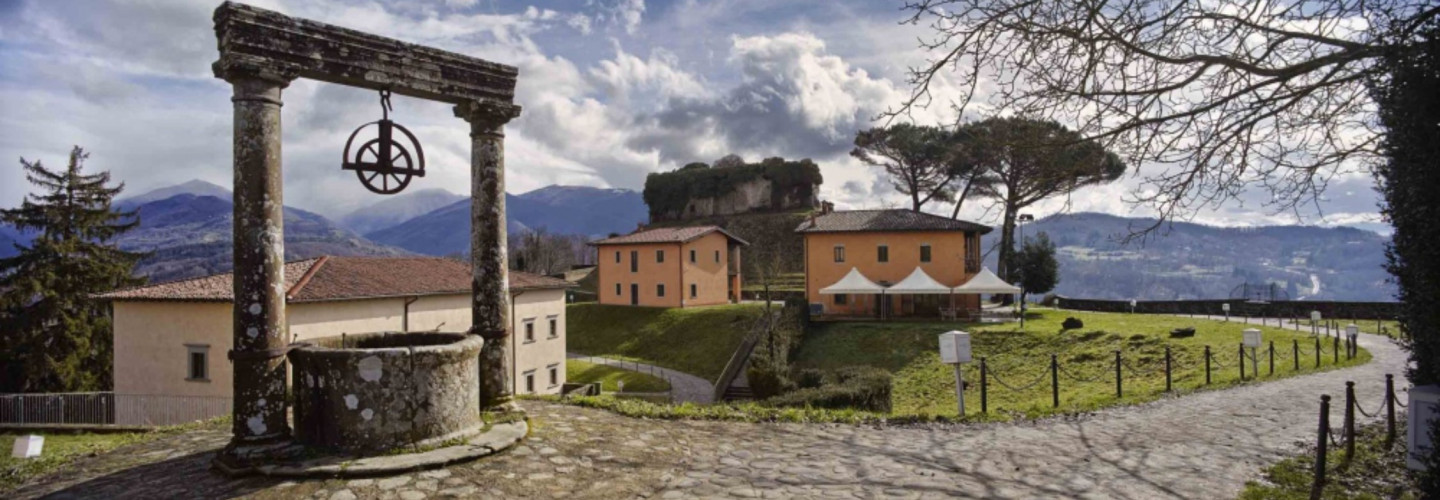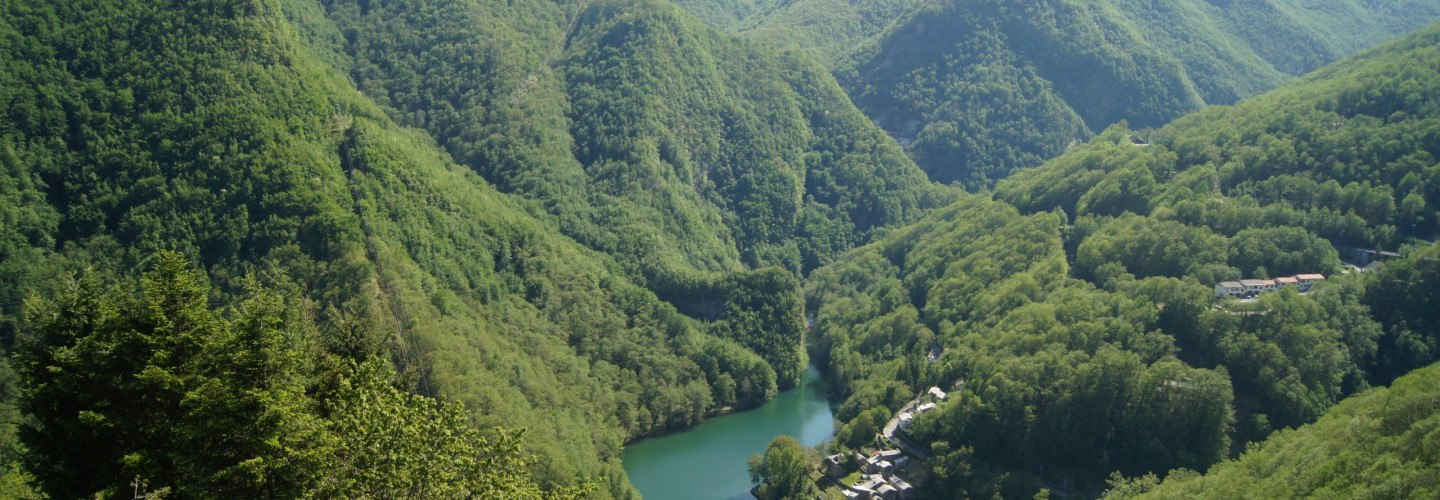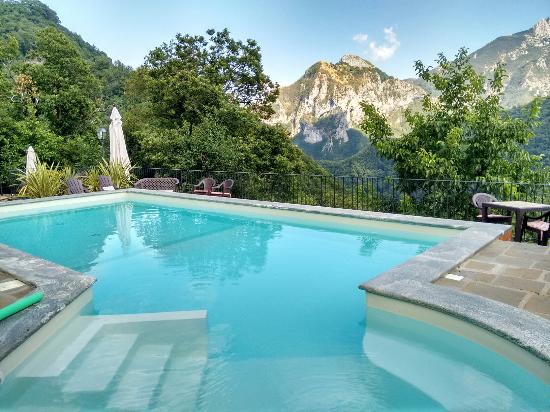Monte Alfonso fortress
It was built by the will of Alfonso II d’Este between 1579 and 1586, on a project by Marc’Antonio Pasi, to defend Castelnuovo Garfagnana and the Este territory from the Republic of Lucca. It was the Garfagnini themselves who contributed, with the huge sum of 30,000 scudi, to the realization.
The complex – with a wall of 1150 meters, 7 bulwarks and two doors – had houses inside: some of the sixteenth-century specimens remain the captain’s house, the accommodation of the troops, the stone well and the casemate bastion. The Este coat of arms still stands on the main door.
According to a popular legend, the Fortress would be connected through an underground gallery to the Rocca Ariostesca di Castelnuovo, a secret passage that, in the event of a siege of the village, would have allowed citizens to take refuge within the walls.
After hosting prisons in the 16th century, in the 1900s it became the summer residence of the Italian – Scottish Bechelli family, who transformed one of the buildings into a modern Liberty villa.
Monte Alfonso fortress

It was built by the will of Alfonso II d’Este between 1579 and 1586, on a project by Marc’Antonio Pasi, to defend Castelnuovo Garfagnana and the Este territory from the Republic of Lucca. It was the Garfagnini themselves who contributed, with the huge sum of 30,000 scudi, to the realization.
The complex – with a wall of 1150 meters, 7 bulwarks and two doors – had houses inside: some of the sixteenth-century specimens remain the captain’s house, the accommodation of the troops, the stone well and the casemate bastion. The Este coat of arms still stands on the main door.
According to a popular legend, the Fortress would be connected through an underground gallery to the Rocca Ariostesca di Castelnuovo, a secret passage that, in the event of a siege of the village, would have allowed citizens to take refuge within the walls.
After hosting prisons in the 16th century, in the 1900s it became the summer residence of the Italian – Scottish Bechelli family, who transformed one of the buildings into a modern Liberty villa.
Isola Santa
Already on 1260 somebody wrote about a “Hospitale” in Isola Santa, that used to assist and give hospitality to those wayfarer who went through the Apuan Alps to reach the Versilia Coast or the Garfagnana in the opposite sense. Along this long and difficult journey Isola Santa was a fixed meeting point, was therefore probably fortified and had a watch tower (lost with centuries, but the street “via della Torre” still remains). Despite its strategic position, the little village was isolated and very difficult to reach due to the bad conditions of the communication routes, and its economy was very poor and simple. This isolation has been preserved for centuries, and ended only with the construction of the road and gallery of Cipollaio at the beginning of the 20th century. After this, in 1949 the construction of the dam changed radically the scene of this valley: the lake caused some troubles to the stability of the village, and the inhabitants of Isola Santa slowly abandoned their houses. The typical houses that we offer to our guests are part of the project of global restoration that has the intent of bringing this little medieval village to life again, to combine its antique charm with the wonders of the natural environment.
Isola Santa

Already on 1260 somebody wrote about a “Hospitale” in Isola Santa, that used to assist and give hospitality to those wayfarer who went through the Apuan Alps to reach the Versilia Coast or the Garfagnana in the opposite sense. Along this long and difficult journey Isola Santa was a fixed meeting point, was therefore probably fortified and had a watch tower (lost with centuries, but the street “via della Torre” still remains). Despite its strategic position, the little village was isolated and very difficult to reach due to the bad conditions of the communication routes, and its economy was very poor and simple. This isolation has been preserved for centuries, and ended only with the construction of the road and gallery of Cipollaio at the beginning of the 20th century. After this, in 1949 the construction of the dam changed radically the scene of this valley: the lake caused some troubles to the stability of the village, and the inhabitants of Isola Santa slowly abandoned their houses. The typical houses that we offer to our guests are part of the project of global restoration that has the intent of bringing this little medieval village to life again, to combine its antique charm with the wonders of the natural environment.
Rocca ariostesca
Dating back to the 11th century, it owes its name to the fact that it hosted the poet Ludovico Ariosto from 1552 to 1525, who held the position of governor of the Este province of Garfagnana during this period.
Architecturally it presents itself with the characteristic shape of medieval buildings: small towers at the corners and a square in the center which also served as a prison.
During the thirteenth century the structure of the fortress was modified and in particular during the period of Lucca’s domination it underwent numerous changes, among which we remember the enlargement of the entire urban walls, operated by Castruccio Castracani degli Antelminelli, and the construction of the imposing tower located in the center of the Rocca, enhanced by the civic clock, thanks to Paolo Guinigi.
In 1675 the terrace was built overlooking the square at the monumental arch leading to the city center.
Following the damage caused during the Second World War, the fortress was restored and modified in the structure. It is currently the site of cultural events and houses the Archaeological Museum, where you can find evidence of the prehistoric, Ligurian-Apuan and Etruscan periods in Garfagnana.
Rocca ariostesca

Dating back to the 11th century, it owes its name to the fact that it hosted the poet Ludovico Ariosto from 1552 to 1525, who held the position of governor of the Este province of Garfagnana during this period.
Architecturally it presents itself with the characteristic shape of medieval buildings: small towers at the corners and a square in the center which also served as a prison.
During the thirteenth century the structure of the fortress was modified and in particular during the period of Lucca’s domination it underwent numerous changes, among which we remember the enlargement of the entire urban walls, operated by Castruccio Castracani degli Antelminelli, and the construction of the imposing tower located in the center of the Rocca, enhanced by the civic clock, thanks to Paolo Guinigi.
In 1675 the terrace was built overlooking the square at the monumental arch leading to the city center.
Following the damage caused during the Second World War, the fortress was restored and modified in the structure. It is currently the site of cultural events and houses the Archaeological Museum, where you can find evidence of the prehistoric, Ligurian-Apuan and Etruscan periods in Garfagnana.
Vecchio Mulino
The restaurant is a Slow Food presidium and stands in the basements of the cathedral above. The proposed menus offer a summary of the products of the area: spelled, bread, pasta, cheeses, hams, sausages and a wide range of fruit jams and drinks.
Vecchio Mulino

The restaurant is a Slow Food presidium and stands in the basements of the cathedral above. The proposed menus offer a summary of the products of the area: spelled, bread, pasta, cheeses, hams, sausages and a wide range of fruit jams and drinks.
+39 0583 62192
Agriturismo La Costa
The unique position of the farm, sorroundend on all sides by oak chestnut woods (in autumn extremely rich in mushrooms and chestnuts), encourage a quite walk in the village or in the surrounding woods, where you can find refuge from the traffic noise and the muggy weather.
The ancient villages of Garfagnana are easly accessible from the agritourism, so this is the ideal location also for the art-lovers. There are also many chances to do some form of sport : swimming in the agritourism swimming pool, horse-riding, trekking, going fishing etc….
All the apartments are originated from the rooms of the ancient cloister, so you can find some well-preserved ancient object. For example you can find the structure and the sink of the ancient kitchen, made of a stone called “serena”, and two magnificent ancient fireplaces, that were used as heating surces for all the cloister. All the jambs of the door inside and outside are the ancient ones: one is particularly decorated, and above one other there is an acient inscription. You can also see the ancient cellar, the farm yard and the wood-burning oven completely restored
Agriturismo La Costa

The unique position of the farm, sorroundend on all sides by oak chestnut woods (in autumn extremely rich in mushrooms and chestnuts), encourage a quite walk in the village or in the surrounding woods, where you can find refuge from the traffic noise and the muggy weather.
The ancient villages of Garfagnana are easly accessible from the agritourism, so this is the ideal location also for the art-lovers. There are also many chances to do some form of sport : swimming in the agritourism swimming pool, horse-riding, trekking, going fishing etc….
All the apartments are originated from the rooms of the ancient cloister, so you can find some well-preserved ancient object. For example you can find the structure and the sink of the ancient kitchen, made of a stone called “serena”, and two magnificent ancient fireplaces, that were used as heating surces for all the cloister. All the jambs of the door inside and outside are the ancient ones: one is particularly decorated, and above one other there is an acient inscription. You can also see the ancient cellar, the farm yard and the wood-burning oven completely restored
Barga
On a rocky spur of the mountain range lies a castle that overlooks Barga’s cityscape. It exemplifies the typical structure of a medieval village and is surrounded by a perimeter wall that is accessible via three gates: Porta Reale, Porta Macchiaia and Porta di Borgo. When walking through the intricate web of alleys and piazzas preserved throughout the course of centuries, you can discover the quirky irregularities of the ancient architecture almost everywhere you look. If you follow via del Pretorio alleys and roads on both the left and right open up before you, where you glimpse tatters of medieval buildings until, going beyond the Piazza Ser Barghesano, you walk out in front of the beautiful vista that is the Cathedral of San Cristoforo.
It is worth noticing in particular the Conservatorio di Santa Elisabetta – originally a monastery of the Clarisse and founded by Beato Michele Turignoli in the 15th century. Then in 1788 it was transformed by Pietro Leopoldo, Grand Duke of Tuscany, into a Conservatory for educating young girls. Its impressive rectangular design was built with three levels, completely surrounding an immense cloister, fitted with extravagant cisterns. Around here, you’ll come across the original walls of Barga’s castle, constructed int eh 16th century. Amongst the furnishings inside the small church belonging to the monks, you can see a beautiful altarpiece of Robbianan design alongside a large 5th-Crucifix and two 6th-century paintings.
The awe-inspiring size of the Cathedral can only be properly understood upon arriving at the top of the castle. Its asymmetrical midpoint is framed by the rooftops of the historic city centre and, more distantly – past the green of the hills punctuated by hamlets and farmsteads – the magnificent crown of the Apuan mountain range.
For literature enthusiasts, only four kilometres from Barga you can discover the hamlet of Castelvecchio Pascoli, where the poet Giovanni Pascoli resided for several years. It is possible to visit the house where he lived with his sisters, and Pascoli even dedicated the memo in the anthology of Canti di Castelvecchio to this hamlet.
Although Barga and all the surrounding areas are an exciting destination throughout the year (for different reasons) it can be a good idea to plan a trip during the summer, possibly even during one of the typical festivals that occur in the area during this time – like the ‘Festa della Piazzette’ or ‘Fish&Chips’ – events where you will certainly have no reason to complain about the portions (of neither food nor alcohol).
Barga

On a rocky spur of the mountain range lies a castle that overlooks Barga’s cityscape. It exemplifies the typical structure of a medieval village and is surrounded by a perimeter wall that is accessible via three gates: Porta Reale, Porta Macchiaia and Porta di Borgo. When walking through the intricate web of alleys and piazzas preserved throughout the course of centuries, you can discover the quirky irregularities of the ancient architecture almost everywhere you look. If you follow via del Pretorio alleys and roads on both the left and right open up before you, where you glimpse tatters of medieval buildings until, going beyond the Piazza Ser Barghesano, you walk out in front of the beautiful vista that is the Cathedral of San Cristoforo.
It is worth noticing in particular the Conservatorio di Santa Elisabetta – originally a monastery of the Clarisse and founded by Beato Michele Turignoli in the 15th century. Then in 1788 it was transformed by Pietro Leopoldo, Grand Duke of Tuscany, into a Conservatory for educating young girls. Its impressive rectangular design was built with three levels, completely surrounding an immense cloister, fitted with extravagant cisterns. Around here, you’ll come across the original walls of Barga’s castle, constructed int eh 16th century. Amongst the furnishings inside the small church belonging to the monks, you can see a beautiful altarpiece of Robbianan design alongside a large 5th-Crucifix and two 6th-century paintings.
The awe-inspiring size of the Cathedral can only be properly understood upon arriving at the top of the castle. Its asymmetrical midpoint is framed by the rooftops of the historic city centre and, more distantly – past the green of the hills punctuated by hamlets and farmsteads – the magnificent crown of the Apuan mountain range.
For literature enthusiasts, only four kilometres from Barga you can discover the hamlet of Castelvecchio Pascoli, where the poet Giovanni Pascoli resided for several years. It is possible to visit the house where he lived with his sisters, and Pascoli even dedicated the memo in the anthology of Canti di Castelvecchio to this hamlet.
Although Barga and all the surrounding areas are an exciting destination throughout the year (for different reasons) it can be a good idea to plan a trip during the summer, possibly even during one of the typical festivals that occur in the area during this time – like the ‘Festa della Piazzette’ or ‘Fish&Chips’ – events where you will certainly have no reason to complain about the portions (of neither food nor alcohol).
La Ceragetta Resort
Ancient mountain village in the Apuan Alps transformed into a romantic hotel spread out in characteristic holiday homes. Accommodation with bathroom and independent entrance, equipped kitchen, cost per person per night or holiday rental houses. Panoramic swimming pool, convivial spaces and services in the village. We are in the Apuan Alps Park in a splendid panoramic position right in front of the Panie Group, mountains with alpine features that divide the Versilia sea from the green Garfagnana, a lush valley in the north of Tuscany.
In the place there is also the well-known and appreciated restaurant. Excellent quality – service / cost ratio. Tastings at Km. 0 based on typical products of the Garfagnana, quality beef, Fario trout, alpine cheeses, IGP spelled, turkish Otto File, porcini mushrooms, raspberries, wild strawberries, chestnuts, honey etc.
La Ceragetta Resort

Ancient mountain village in the Apuan Alps transformed into a romantic hotel spread out in characteristic holiday homes. Accommodation with bathroom and independent entrance, equipped kitchen, cost per person per night or holiday rental houses. Panoramic swimming pool, convivial spaces and services in the village. We are in the Apuan Alps Park in a splendid panoramic position right in front of the Panie Group, mountains with alpine features that divide the Versilia sea from the green Garfagnana, a lush valley in the north of Tuscany.
In the place there is also the well-known and appreciated restaurant. Excellent quality – service / cost ratio. Tastings at Km. 0 based on typical products of the Garfagnana, quality beef, Fario trout, alpine cheeses, IGP spelled, turkish Otto File, porcini mushrooms, raspberries, wild strawberries, chestnuts, honey etc.
La Ceragetta Restaurant
The right place to season the excursions with the right amount of refreshment, in search of traditional flavors of the Apuan Garfagnana cuisine
La Ceragetta Restaurant

The right place to season the excursions with the right amount of refreshment, in search of traditional flavors of the Apuan Garfagnana cuisine